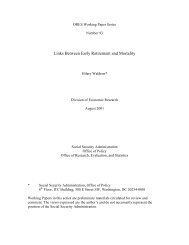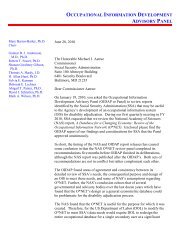Table 4.Estimated occupational distributions of the employed population with disabilities, by occupationalchoicemodel aOccupationSSI recipientsNon-SSI recipients with—No disability Any disability Work disabilityTotal 100.00 100.00 100.00 100.00Management, professional, and related 18.46 29.03 25.87 22.70Management 4.38 9.06 6.94 5.67Business and financial operations 2.55 3.70 3.15 2.77Computer and mathematical, architecture andengineering, life, physical and social science 1.23 3.98 3.64 2.73Community and social services 2.35 1.26 1.71 1.54Legal 0.45 0.87 0.74 0.64Education, training, and library 3.36 4.21 4.32 3.91Arts, design, entertainment, sports, and media 2.27 1.57 1.43 1.60Health-care practitioner and technical 1.88 4.39 3.93 3.85Service 27.95 17.21 20.53 22.90Health-care support 2.17 2.41 2.95 3.08Protective service 2.00 2.09 2.11 2.05Food preparation and serving related 6.83 5.00 5.74 6.25Building and grounds cleaning and maintenance 9.32 4.38 5.80 6.65Personal care and service 7.63 3.33 3.93 4.88Sales and office 27.17 26.47 25.54 24.55Sales and related 10.84 10.98 10.65 10.99Office and administrative support 16.32 15.49 14.89 13.34Farming, fishing, and forestry 0.76 0.68 0.73 0.81Construction, extraction, maintenance, and repair 7.66 11.34 10.92 12.19Production, transportation, and material moving 18.01 15.28 16.43 17.06Production 7.15 8.06 8.33 8.08Transportation and material moving 10.86 7.22 8.09 8.98SOURCE: Author's calculations using the 2007 American Community Survey.NOTES: The sum of individual categories may not equal the total because of rounding.a. The occupational-choice models are based on separate multinomial logit regressions of occupation for each population group.Covariates in all models include sex, ethnicity, race, marital status, education, age, and age squared. The disabled, work-disabled, andworking-SSI models also include disability type as additional covariates. All estimates use ACS balanced repeated replicate sampleweights. See Table A-3 for the results of the models.population. Thus, Table 3 shows the predicted occupationaldistribution the working SSI population wouldhave if their observable characteristics affected theiroccupational choice in the same manner as the referencepopulation. Note that the predicted occupationaldistribution of a group based on its own populationmodel is identical to the actual distribution in Table 1,although the standard errors are slightly different. 18Considering the occupational distributions of theworking SSI population (Table 3), fewer SSI recipientswould work in service occupations (from 34 percent to22 percent) and production, transportation, and materialmoving occupations (from 30 percent to 18 percent)if their occupations were distributed accordingto the no-disability occupational-choice model.Additionally, more working SSI recipients would bein construction, extraction, maintenance, and repairoccupations (from 4 percent to 13 percent) and management,professional, and related occupations (from10 percent to 19 percent) under the this model.Most of the individual occupations see changes ofless than 1 percentage point. The largest change is thereduction of SSI recipients working in building andgrounds cleaning and maintenance (from 15 percent to5 percent). The following occupations all see achange of more than 3 percentage points under theno-disability occupational-choice model: management;office and administrative support; construction,56 <strong>Social</strong> <strong>Security</strong> Bulletin • Vol. 69 • No. 3 • 2009
Table 5.Estimated occupational distributions of the employed population without disabilities, by occupationalchoicemodel aOccupationSSI recipientsNon-SSI recipients with—No disability Any disability Work disabilityTotal 100.00 100.00 100.00 100.00Management, professional, and related 21.61 35.62 34.22 29.74Management 6.32 9.88 8.68 7.41Business and financial operations 1.64 4.55 4.32 3.55Computer and mathematical, architecture andengineering, life, physical and social science 1.28 5.45 5.42 4.20Community and social services 3.14 1.58 1.91 1.64Legal 0.58 1.17 0.96 0.90Education, training, and library 3.16 5.84 6.37 5.40Arts, design, entertainment, sports, and media 2.56 1.92 1.65 1.62Health-care practitioner and technical 2.94 5.23 4.90 5.01Service 24.71 15.97 16.83 20.58Health-care support 1.53 2.20 2.81 3.29Protective service 1.69 2.10 1.73 2.08Food preparation and serving related 7.13 4.99 5.02 5.66Building and grounds cleaning and maintenance 8.09 3.58 4.12 5.11Personal care and service 6.27 3.10 3.14 4.46Sales and office 30.47 25.15 25.27 23.61Sales and related 11.37 11.00 10.69 11.11Office and administrative support 19.09 14.15 14.59 12.50Farming, fishing, and forestry 0.52 0.67 0.71 0.85Construction, extraction, maintenance, and repair 8.47 10.02 9.17 10.18Production, transportation, and material moving 14.22 12.57 13.80 15.04Production 5.10 6.64 7.22 7.35Transportation and material moving 9.12 5.94 6.57 7.70SOURCE: Author's calculations using the 2007 American Community Survey.NOTES: The sum of individual categories may not equal the total because of rounding.a. The occupational-choice models are based on separate multinomial logit regressions of occupation for each population group.Covariates in all models include sex, ethnicity, race, marital status, education, age, and age squared. The disabled, work-disabled, andworking-SSI models also include disability type as additional covariates. All estimates use ACS balanced repeated replicate sampleweights. See Table A-3 for the results of the models.extraction, maintenance and repair; production; andtransportation and material moving.Similar movements occur under the disability andwork-related disability occupational-choice models,which yield similar results. For example, the percentageof working SSI recipients in management,professional, and related occupations increases from9 percent to about 15 percent under these models,and the percentage in production, transportation, andmaterial moving occupations falls from 30 percent toabout 20–22 percent under these models.Tables 4, 5, and 6 present similar estimates for thepopulations with any disability, no disability, and awork disability, respectively. 19 Because this article isfocused on the SSI population, only the differencesbetween the actual distributions and the working-SSImodel are discussed here. As would be expected,when the working-SSI model is used to predict occupationaldistributions, the reverse of what was seen inTable 3 occurs. For example, the percentage of thosewith disabilities in management, professional, andrelated occupations falls from 26 percent to 18 percent(Table 4). Similarly, the decrease in the percentagein these occupations under the working SSI occupational-choicemodel is from 36 percent to 22 percentfor the population without a disability (Table 5) and23 percent to 20 percent for the population with a workdisability (Table 6).<strong>Social</strong> <strong>Security</strong> Bulletin • Vol. 69 • No. 3 • 2009 57
- Page 1 and 2:
Social SecuritySocial SecurityBulle
- Page 3:
Social SecurityBulletin Vol. 69, No
- Page 6 and 7:
Perspectives77 An Empirical Study o
- Page 8 and 9:
Selected Abbreviations—continuedM
- Page 10:
within the next few years (Aglira 2
- Page 14 and 15: coverage varies significantly by ra
- Page 16 and 17: non-Hispanic white, and college edu
- Page 18 and 19: same groups (Table 6). For the last
- Page 20 and 21: from DB to DC pensions is accelerat
- Page 22 and 23: Table 8.Percent of individuals who
- Page 24 and 25: not necessarily the largest gains a
- Page 26 and 27: shoring-up DB plans before those pl
- Page 28 and 29: Table B-1.Percent change in mean pe
- Page 30 and 31: Table B-3.Percent of individuals wh
- Page 32 and 33: ReferencesAaronson, Stephanie, and
- Page 35 and 36: Social Security Administration’s
- Page 37: Chart 1.Historical expansion of Soc
- Page 40 and 41: self-employment information for the
- Page 42 and 43: (Cronin 1985). The final earnings r
- Page 44 and 45: prior to 1950, first year of earnin
- Page 46 and 47: average indexed monthly earnings (A
- Page 48 and 49: 13For an explanation of how the sel
- Page 50 and 51: Kopczuk, Emmanuel Saez, and Jae Son
- Page 53 and 54: Occupations of SSI Recipients Who W
- Page 55 and 56: on the differences between the occu
- Page 57 and 58: prediction models. Table A-1 lists
- Page 59 and 60: Occupational Distributions of theEm
- Page 61: similar, only 4 percent of the popu
- Page 65 and 66: Table 7.Predicted Herfindahl-Hirsch
- Page 67 and 68: Table 9.Estimated occupational dist
- Page 69 and 70: Table 11.Average annual wages of wo
- Page 71 and 72: Table A-2.Means and standard errors
- Page 73 and 74: Table A-3.Coefficients and standard
- Page 75 and 76: Table A-3.Coefficients and standard
- Page 77 and 78: Table A-3.Coefficients and standard
- Page 79 and 80: management, professional, and relat
- Page 81: Stapleton, David C., Nanette Goodma
- Page 84 and 85: Selected Abbreviations—continuedO
- Page 86 and 87: The 1983 Amendments to the Social S
- Page 88 and 89: Chart 1.Proportion of new claimants
- Page 90 and 91: Table 4.The evolution of the ARF an
- Page 92 and 93: for the test of equality of means b
- Page 94 and 95: Table 8.Average monthly Social Secu
- Page 96 and 97: in the chart, especially for men, t
- Page 98 and 99: 6This is a very important character
- Page 100 and 101: Benítez-Silva, Hugo, Berna Demiral
- Page 103 and 104: OASDI and SSI Snapshot andSSI Month
- Page 105 and 106: Monthly Statistical Snapshot, Augus
- Page 107 and 108: Table 2.Recipients, by eligibility
- Page 109 and 110: SSI Federally Administered Payments
- Page 111 and 112: Table 7.Average monthly payment, by
- Page 113:
Awards of SSI Federally Administere
- Page 116 and 117:
Copyright—Authors are responsible
- Page 119 and 120:
Program Highlights, 2009Old-Age, Su








